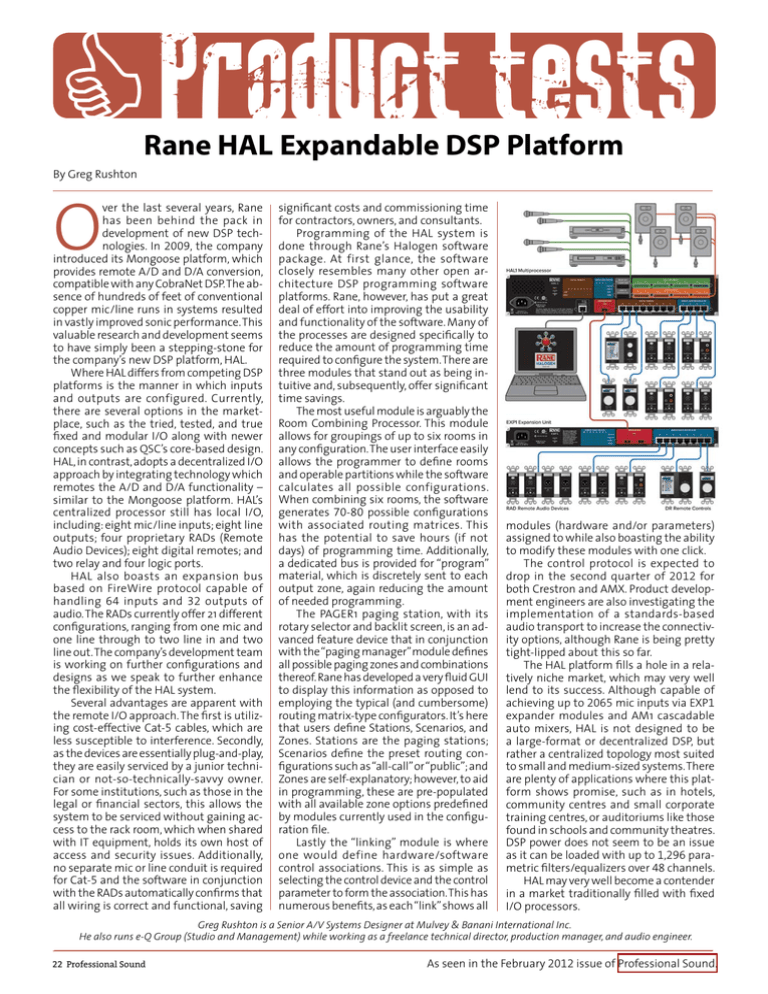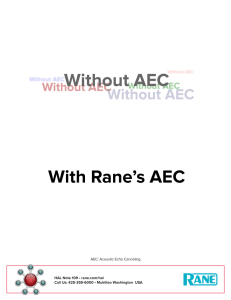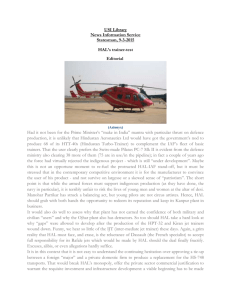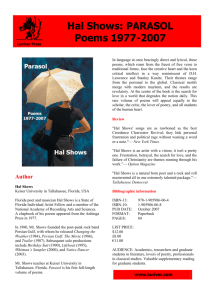O
advertisement

Product tests Rane HAL Expandable DSP Platform By Greg Rushton O ver the last several years, Rane has been behind the pack in development of new DSP technologies. In 2009, the company introduced its Mongoose platform, which provides remote A/D and D/A conversion, compatible with any CobraNet DSP. The absence of hundreds of feet of conventional copper mic/line runs in systems resulted in vastly improved sonic performance. This valuable research and development seems to have simply been a stepping-stone for the company’s new DSP platform, HAL. Where HAL differs from competing DSP platforms is the manner in which inputs and outputs are configured. Currently, there are several options in the marketplace, such as the tried, tested, and true fixed and modular I/O along with newer concepts such as QSC’s core-based design. HAL, in contrast, adopts a decentralized I/O approach by integrating technology which remotes the A/D and D/A functionality – similar to the Mongoose platform. HAL’s centralized processor still has local I/O, including: eight mic/line inputs; eight line outputs; four proprietary RADs (Remote Audio Devices); eight digital remotes; and two relay and four logic ports. HAL also boasts an expansion bus based on FireWire protocol capable of handling 64 inputs and 32 outputs of audio. The RADs currently offer 21 different configurations, ranging from one mic and one line through to two line in and two line out. The company’s development team is working on further configurations and designs as we speak to further enhance the flexibility of the HAL system. Several advantages are apparent with the remote I/O approach. The first is utilizing cost-effective Cat-5 cables, which are less susceptible to interference. Secondly, as the devices are essentially plug-and-play, they are easily serviced by a junior technician or not-so-technically-savvy owner. For some institutions, such as those in the legal or financial sectors, this allows the system to be serviced without gaining access to the rack room, which when shared with IT equipment, holds its own host of access and security issues. Additionally, no separate mic or line conduit is required for Cat-5 and the software in conjunction with the RADs automatically confirms that all wiring is correct and functional, saving significant costs and commissioning time for contractors, owners, and consultants. Programming of the HAL system is done through Rane’s Halogen software package. At first glance, the software closely resembles many other open architecture DSP programming software platforms. Rane, however, has put a great deal of effort into improving the usability and functionality of the software. Many of the processes are designed specifically to reduce the amount of programming time required to configure the system. There are three modules that stand out as being intuitive and, subsequently, offer significant time savings. The most useful module is arguably the Room Combining Processor. This module allows for groupings of up to six rooms in any configuration. The user interface easily allows the programmer to define rooms and operable partitions while the software calculates all possible configurations. When combining six rooms, the software generates 70-80 possible configurations with associated routing matrices. This has the potential to save hours (if not days) of programming time. Additionally, a dedicated bus is provided for “program” material, which is discretely sent to each output zone, again reducing the amount of needed programming. The PAGER1 paging station, with its rotary selector and backlit screen, is an advanced feature device that in conjunction with the “paging manager” module defines all possible paging zones and combinations thereof. Rane has developed a very fluid GUI to display this information as opposed to employing the typical (and cumbersome) routing matrix-type configurators. It’s here that users define Stations, Scenarios, and Zones. Stations are the paging stations; Scenarios define the preset routing configurations such as “all-call” or “public”; and Zones are self-explanatory; however, to aid in programming, these are pre-populated with all available zone options predefined by modules currently used in the configuration file. Lastly the “linking” module is where one would define hardware/software control associations. This is as simple as selecting the control device and the control parameter to form the association. This has numerous benefits, as each “link” shows all modules (hardware and/or parameters) assigned to while also boasting the ability to modify these modules with one click. The control protocol is expected to drop in the second quarter of 2012 for both Crestron and AMX. Product development engineers are also investigating the implementation of a standards-based audio transport to increase the connectivity options, although Rane is being pretty tight-lipped about this so far. The HAL platform fills a hole in a relatively niche market, which may very well lend to its success. Although capable of achieving up to 2065 mic inputs via EXP1 expander modules and AM1 cascadable auto mixers, HAL is not designed to be a large-format or decentralized DSP, but rather a centralized topology most suited to small and medium-sized systems. There are plenty of applications where this platform shows promise, such as in hotels, community centres and small corporate training centres, or auditoriums like those found in schools and community theatres. DSP power does not seem to be an issue as it can be loaded with up to 1,296 parametric filters/equalizers over 48 channels. HAL may very well become a contender in a market traditionally filled with fixed I/O processors. Greg Rushton is a Senior A/V Systems Designer at Mulvey & Banani International Inc. He also runs e-Q Group (Studio and Management) while working as a freelance technical director, production manager, and audio engineer. 22 Professional Sound As seen in the February 2012 issue of Professional Sound.




